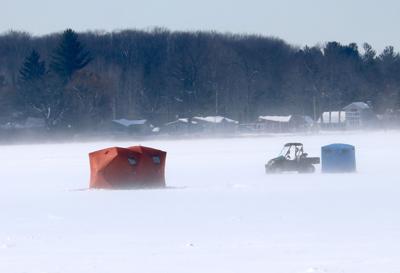Those who enjoy ice fishing may not like this story.
The Department of Natural Resources said anglers who enjoy ice fishing should keep a close watch on ice conditions as recent unseasonable weather may prompt the need to remove shanties before the normal seasonal dates.
People venturing onto ice should use extreme caution as temperatures begin to rise or fluctuate. The repeated thawing and refreezing of ice weaken its strength, decreasing its ability to support the additional weight of people, snowmobiles, ORVs and shanties. Deteriorating ice, water currents and high winds increase the probability of pressure cracks, which can leave anglers and others stranded on ice floes or at risk of falling through the ice.
DNR Fisheries Biologist Mark Tonello said the potential early thaw there are potential negative outcomes as a result of an early thaw. Tonello said that includes excess nuisance aquatic plant growth, like Eurasian watermilfoil, and early algae bloom. He also was quick to point out it also will be dependent on what the weather is like once the ice is off the lakes if the thaw comes early.
“Nuisance plant growth and algae blooms can come early if early spring comes,” he said. “Those are the things that can occur with climate change.”
Tonello said lake levels also can be at risk if there is an early thaw. Again, that will be dependent on if there is rain or if it remains dry once the ice is off. He said that happened a few years ago when Lake Mitchell was at its summer low level for lake levels in April.
Although there are some potential ill effects an early thaw can produce, Tonello said there also are some positives.
“Walleye and pike seasons close on March 15, so there is potential you can get out and fish before March 15 for walleye and pike. The fishing can be good,” he said. “If you like to steelhead fish, late February and early March are good times to do that.
REMOVAL DATES
Daily use of ice shanties is permitted anywhere in Michigan if ice conditions allow and if the shanties are removed from the ice at the end of each day.
Seasonal removal dates begin with Lake St. Clair, located northeast of Detroit. This year, shanties must be removed from Lake St. Clair before sunset Sunday, Feb. 26.
Shanties in the northern Lower Peninsula must be removed by midnight Wednesday, March 15. Those counties include Alcona, Alpena, Antrim, Arenac, Bay, Benzie, Charlevoix, Cheboygan, Clare, Crawford, Emmet, Gladwin, Grand Traverse, Iosco, Isabella, Kalkaska, Lake, Leelanau, Manistee, Mason, Mecosta, Midland, Missaukee, Montmorency, Newaygo, Oceana, Ogemaw, Osceola, Oscoda, Otsego, Presque Isle, Roscommon and Wexford.
Ice shanties in the remaining counties of the Lower Peninsula must be removed by midnight Wednesday, March 1.
In the Upper Peninsula, on Michigan-Wisconsin boundary waters, ice shanties must be removed by midnight Wednesday, March 15.
All other bodies of water in the Upper Peninsula must have ice shanties removed by midnight Friday, March 31.
Shanty owners whose structures fall through the ice are subject to penalties of up to 30 days in jail, fines up to $500, or both. If a shanty is removed by a government agency, the court can require the owner to reimburse that agency for up to three times the cost of removal.












Commented
Sorry, there are no recent results for popular commented articles.